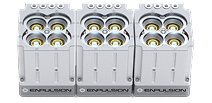Qualification Status of the Field-Emission Electric Propulsion (FEEP) Systems Nano R3 and Micro R3
Abstract:
Field-emission electric propulsion (FEEPs) as part of the electrostatic propulsion family are low-thrust, high-Isp subsystems suitable for various mission applications on satellites ranging from Cubesats over constellations to larger satellites and can be easily clustered to fulfil mission requirements.
Based on space-proven liquid metal ion source (LMIS) technology, FOTEC developed the IFM Nano Thruster as a standalone FEEP subsystem including propellant management and electronics (PPU) resulting in a first IOD in early 2018. The technology is now being commercialized as ENPULSION NANO thruster by the spin-out company ENPULSION and has resulted in delivery of several hundred thrusters and more than 100 thruster units in orbit (as of Q1 2022).
Further R&D efforts at both ENPULSION and FOTEC have resulted in new products: the NANO R³ as an evolutionary step based on the NANO as well as the MICRO R³ based on the same technology for more demanding mission requirements. Both products are now being qualified within an ESA qualification project, and the current status and results are presented herein.



